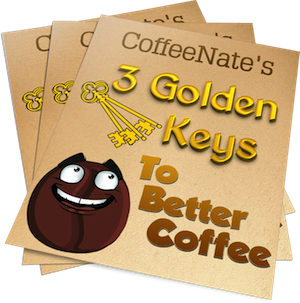Learn how to love coffee

Make Better Coffee
Complete this simple form to get Nate's email mini-series and absolutely transform your coffee experience!
COFFEE DEALS!
Coffee Friends
Categories
- Announcements
- Black Friday Deals
- Brewing Methods
- Coffee & Health
- Coffee Accessory Reviews
- Coffee Brewer Reviews
- Coffee Certification Programs
- Coffee Commentary
- Coffee Events
- Coffee Grinder Reviews
- Coffee Humor
- Coffee Origins
- Coffee People
- Coffee Processing
- Coffee Reviews
- Coffee Shop Reviews
- Coffee Terms
- Coffee Tips
- Cyber Monday Deals
- Direct Trade
- espresso
- Espresso Machine Review
- Fair Trade
- Get Ready
- Gift Ideas
- Guest Posts
- home roasting
- How To
- Last Minute Deal
- Lists
- Monday Morning Meme
- National Coffee Day Deals
- Podcast
- Premium Coffees
- Single Serve Coffee
Copyright © 2025 · CoffeeNate.com · Privacy Policy




Nate’s Top 5 Misused & Abused #Coffee Terms
Disclosure: I may receive compensation when readers purchase products after clicking links on this site. This does not affect my opinion or the price you pay, but does help support my work. Reviewed products may have been provided at no cost.
Misused Coffee Terms
Have a coffee question…ASK COFFEENATE!
“Strong coffee“…”Bold coffee” These as well as other coffee related terms have been misused and abused over and over, making it very difficult for new coffee lovers to break the code. Here my list of the top 5 most misused and misleading coffee terms. There are many more, so I invite you to share your own thoughts and favorites in the comment section below 🙂
Showing the coffee bean roasting stages from green to charcoal
norm. A coffee that is dark roasted is quite simply one that has been roasted for a longer period of time, or at higher temperatures. When a coffee is dark roasted, very little of its unique terroir (unique conditions of the growing region; ie soil drainage/makeup, precipitation, elevation) flavor remains, and nearly all of the flavor is from the roasting process itself. These coffees tend to be more bittersweet and smoky in their flavor. It is not appropriate to refer to a dark roasted coffee as ‘strong’ coffee.
LIGHT roast coffee: Some people think that lighter roasted coffee is weaker in flavor. This is certainly not the case, rather it is a different type of flavor. Lighter roasted coffee derives a large amount of its flavor due to its terroir. These unique flavors can range from a bursting blueberry Harrar to rooty/earthy Sumatran. Again, the strength of the coffee is determined by the coffee/water ratio. That being said the definition of ‘light’ roast is a bit subjective, and varies from roaster to roaster. I’ve seen ‘light’ roasted coffee that was dark as night and as shiny as a freshly minted penny. I have also seen ‘light’ roasted coffee that was light tan and barely roasted. Personally, I define a light roast as a coffee that is medium to light brown in color, has no shiny oil on the surface of the bean, yet is roasted hot and long enough to allow the chemical reactions inside the bean occur that produces the optimum flavor. My sweet spot is between numbers 8-12 on the chart.
Green Mountain's "BOLD" can be light roasted
What great 'spro looks like
Espresso: Newsflash folks…Espresso is not a variety of coffee bean or a special degree of roasting. True, you will find companies that market ‘espresso beans’ or an ‘espresso roast’, these are misleading. Espresso is simply a coffee brewing method in which hot water is forced through a bed of finely ground coffee with at least 9 atm of pressure. You can brew espresso with light, medium, or dark roasted coffee. It is a common misconception that espresso is brewed with only dark roasted coffee. In fact, I prefer espresso made with a lighter medium roasted coffee.
Sadly enough, properly brewed espresso is not a very easy thing to find.
For instance, there are 5 coffee shops that I’ve ordered espresso from in my town, and they have all been very sub-par! They all used coffee that was ground some time before I even entered the shop, tamped at about 1lb of pressure, and used dirty portafilters, creating a wonderful imitation of ashtray water. If your idea of espresso is bitter nasty cigarette butt water, then obviously you know what I mean. I challenge you to find a ‘real’ barista and try a shot of espresso. A good indicator is if there is a layer of creamy brown foam on top, known as crema. Another hint will be the volume of the shot, it should be just an ounce or two…not 8 like one local shop here serves up!
Say something!